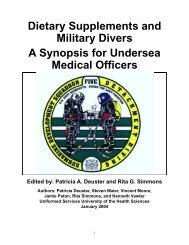Force Health Protection: Nutrition and Exercise Resource Manual
Force Health Protection: Nutrition and Exercise Resource Manual
Force Health Protection: Nutrition and Exercise Resource Manual
You also want an ePaper? Increase the reach of your titles
YUMPU automatically turns print PDFs into web optimized ePapers that Google loves.
Which classification in Table 7-1 best matches the requirements of your<br />
job? Which classification best describes your leisure activities?<br />
Muscle Fiber Types<br />
Before discussing strength training exercises <strong>and</strong><br />
guidelines, here is a quick review of muscle physiology. To<br />
generate force, muscles contract. This action requires ATP<br />
(see Chapter 4, page 31). Muscle fibers are classified<br />
according to which energy system they use to make ATP.<br />
The three types of skeletal muscle fibers are:<br />
◆ Slow Twitch Oxidative (Type I) fibers are mostly involved in<br />
endurance activities. They rely on ATP from aerobic energy<br />
metabolism (see page 31) <strong>and</strong> are generally resistant to fatigue.<br />
◆ Fast Twitch Glycolytic (Type IIb) fibers are involved in quick,<br />
strong muscle contractions <strong>and</strong> rely on the anaerobic energy<br />
systems to produce ATP. These fibers are susceptible to fatigue.<br />
◆ Fast Twitch Oxidative-Glycolytic (Type IIa) fibers are a cross<br />
between the slow <strong>and</strong> fast twitch fibers since they rely on both<br />
aerobic <strong>and</strong> anaerobic systems (see page 31) for energy.<br />
Everyone has all three muscle fiber types; however, genetics determine<br />
which fiber type is more abundant in each person. Physical training can lead<br />
to changes in the characteristics of the muscle fibers. For example, endurance<br />
training makes the Type IIa fiber act more like the slow-twitch, Type I fiber.<br />
Determinants of Muscle Size<br />
Apart from muscle fiber type, various factors influence muscle size (see<br />
Figure 7-1). Although some factors cannot be controlled, two factors that we<br />
can control are exercise <strong>and</strong> nutrition habits (Chapters 3, 4, <strong>and</strong> 11).<br />
<strong>Nutrition</strong> <strong>and</strong> <strong>Exercise</strong> <strong>Resource</strong> <strong>Manual</strong> 57




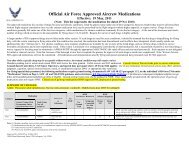

![Body Composition and Military [PDF] - Human Performance ...](https://img.yumpu.com/43269347/1/190x245/body-composition-and-military-pdf-human-performance-.jpg?quality=85)
![Tips for Grocery Shopping [PDF]](https://img.yumpu.com/37447379/1/190x245/tips-for-grocery-shopping-pdf.jpg?quality=85)
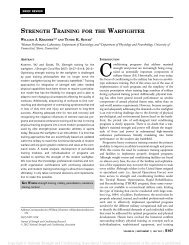
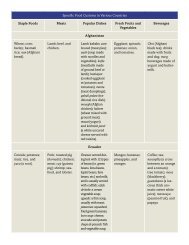
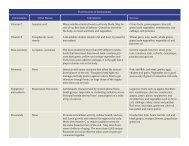
![Synthetic Drugs [PDF] - Human Performance Resource Center](https://img.yumpu.com/37447322/1/190x245/synthetic-drugs-pdf-human-performance-resource-center.jpg?quality=85)
